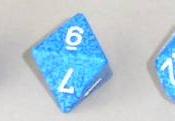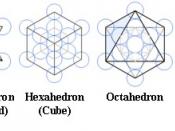THE PLATONIC SOLIDS
The Platonic Solids are the regular polyhedrons. There are only five of them. They are the tetrahedron, hexahedron (cube), octahedron, dodecahedron and icosahedron. The first three mentioned have been known since ancient times. The remaining two plus the original three were definitely known by the Pythagoreans. Plato believed that the elements were shaped like the platonic solids; that they were the solids.
The tetrahedron represents fire since fire is the lightest element and has a sharp sting. The three upper triangles represent solar fire, volcanic fire, and astral fire. The base triangle represents latent heat. The upper triangles are also linked to the three fire zodiac signs, Aries, Sagittarius, and Leo.
The Hexahedron corresponds to the earth since the cube is very stable, much like the earth. Ironically, the cube isn't very stable. When a toothpick model is made, it can be noted that it will most likely tend to distort or collapse.
However, if a tetrahedron is inscribed inside a cube the cube will become more stable. If you inscribe two tetrahedrons inside a cube it will form what is known as a "Stella Octangula". This can be a representation of the complementing between positive and negative forces.
The octahedron is represents the air. This is because fire, air and water react mostly with each other and therefore must have atoms similar in shape. The Tetrahedron, the octahedron, and the Icosahedron are all comprised of triangles. Air's the octahedron, since it's the second lightest atom and the octahedron has the second least number of sides of the three that make up fire, air, and water.
The dodecahedron is attributed to both the cosmos and spirit. This is most likely because it was the last to be discovered and it's pentagonal faces. Naturally, it's twelve faces...


